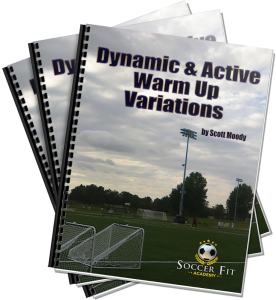A good pregame warm-up should get a team physically and mentally prepared to play from the first whistle. You can look for some patterns that may point to a need to change how your team warms up before matches.
Does your team often have a slow start or go down a goal early?
Does your team always play better in the second half?
If you answer yes to these question then the issue may be with your warm-up. This free eBook from our Conditioning Experts at Soccer FIT Academy will give you a template for creating a warm-up that will have your team focused and fast right from the start.
What is the primary focus of a warm up, and how can we progress our warm ups in stages? In our program we utilize a 7 step process...
1) Emotional Readiness (Heart Rate Low)
2) Focus / Concentration (Heart Rate Low)
3) Stationary Dynamic Flexibility / Mobility (Heart Rate Slow Increase)
4) Stationary Stabilizer and Prime Move Activation (Heart Rate Slow Increase)
5) Rhythmic to Dynamic Movement Coordination (Heart Rate Moderate Level)
6) Dynamic Skill Coordination (Heart Rate Elevated to Ideal Level)
7) Task Specific Lead In (Heart Rate Low, Recovery)
We start with a focus on emotional readiness where we explain the plan or session (let the players know what we will be doing that day). We ask questions about fatigue/soreness and try to identify any specific reasons why we might want to consider making adjustments to our planned activity. We then start things off with a focus or concentration activity. This could be a continued conversation about the session plan, or we could ask questions about the previous session or game. We would get everyone on the same page and set some goals for the upcoming session (what do you want to get out of this session, and what are you going to specifically focus on to make sure you reach your goal).
Next we move into a stationary approach to flexibility/mobility and slowly increase the heart rate. This varies depending on the level of the group and the activity we had planned. From there we work from stabilizers to prime movers (again, mainly dependent upon the planned activity). We then start to move more rhythmically and dynamically in movement patterns as we increase the heart rate to a moderate level with a primary focus on coordination and/or footwork.
At this point it's time to begin to integrate a skill component that ties into our planned session as we elevate the heart rate to a game like level. With the players focused, and prepared to move, think and react more efficiently, we can get right into the specific session.
[wpsharely id="6889"] [/wpsharely]In this free online manual, we will take a closer look at static and dynamic activities, integrated agility and ball skills, as well as an age appropriate progression for various warm ups. This manual will focus on how you can incorporate different styles of warm ups into your training at different stages to keep the athletes focused and target specific training outcomes.
Have a great day!
Tom



